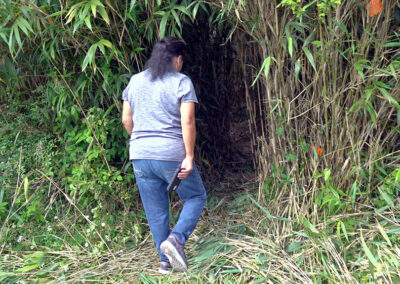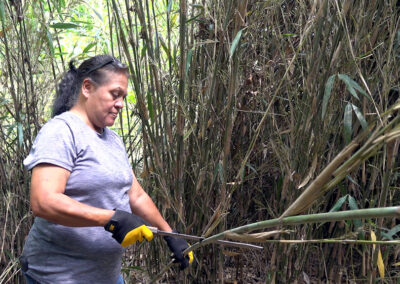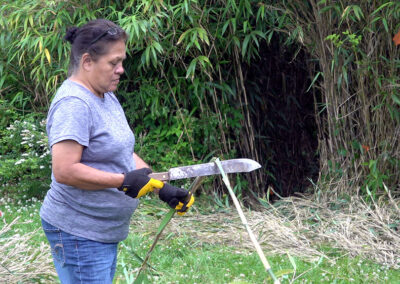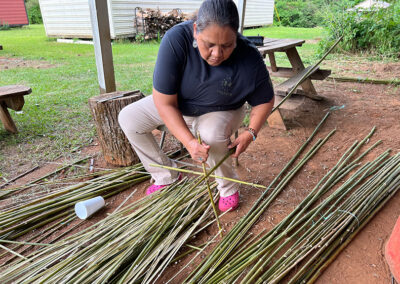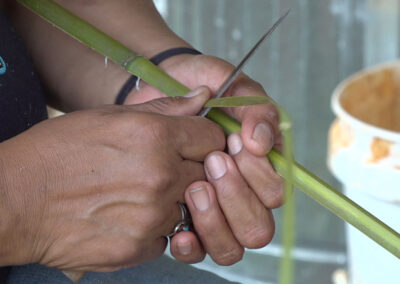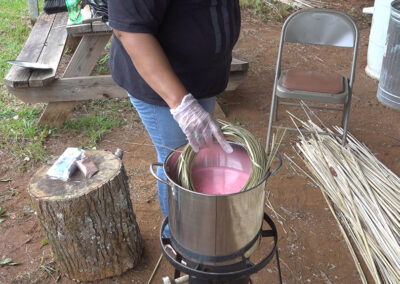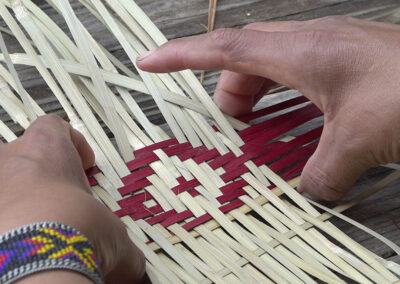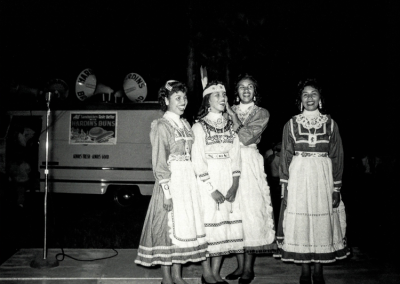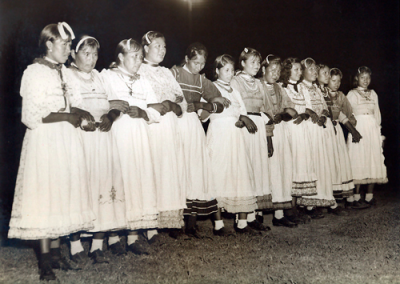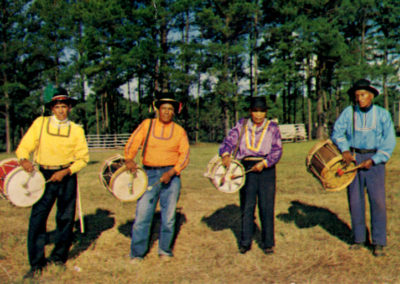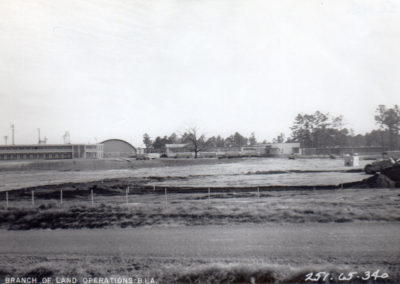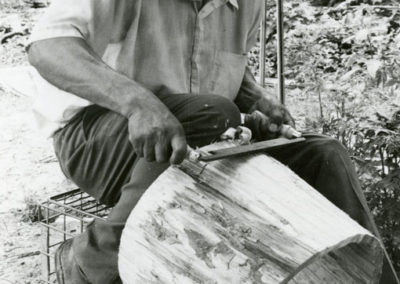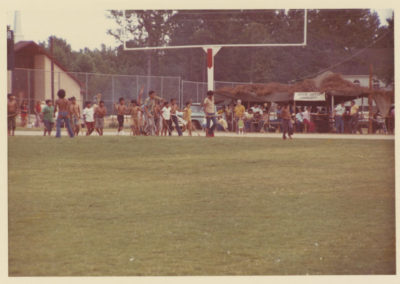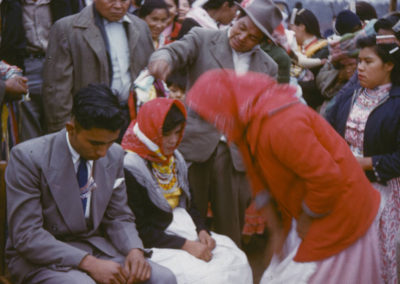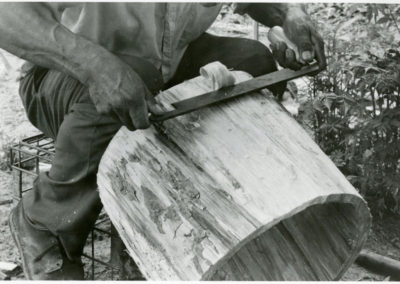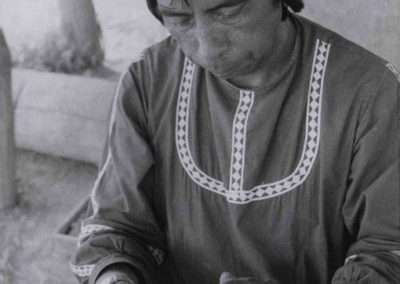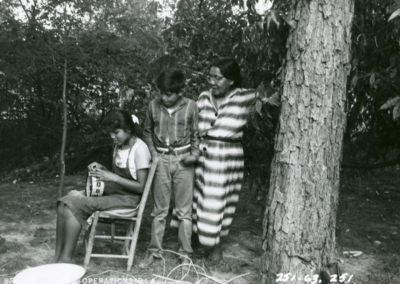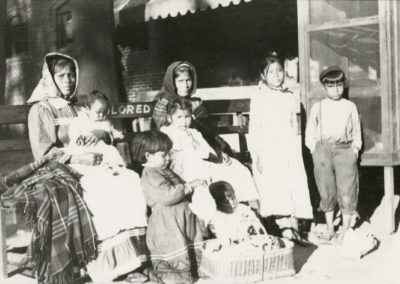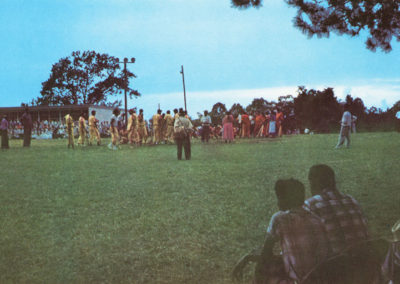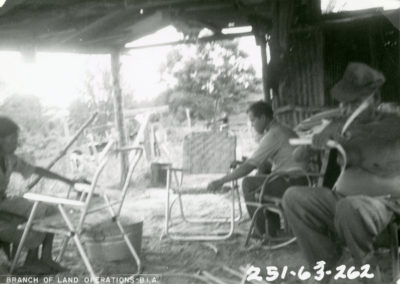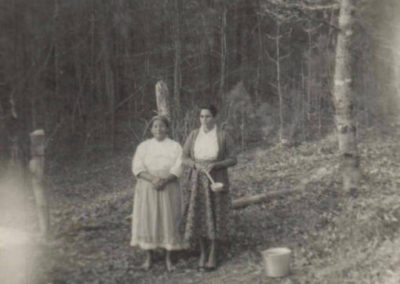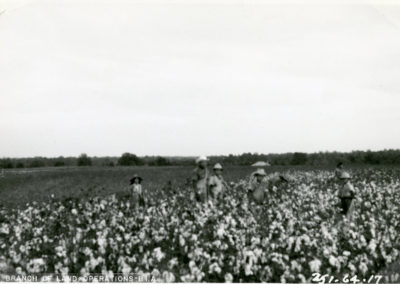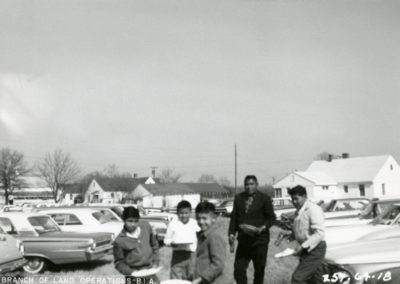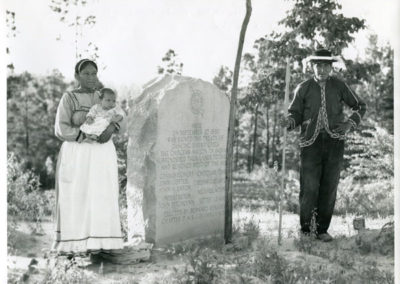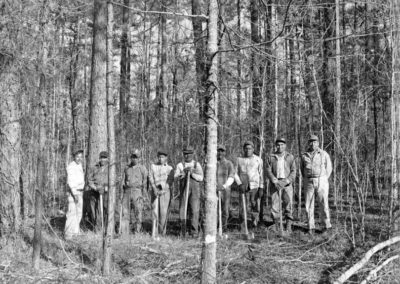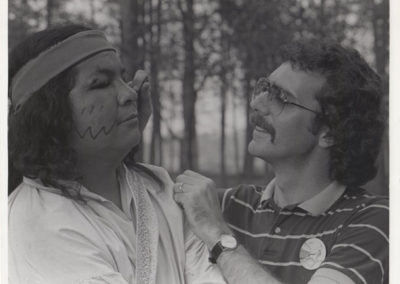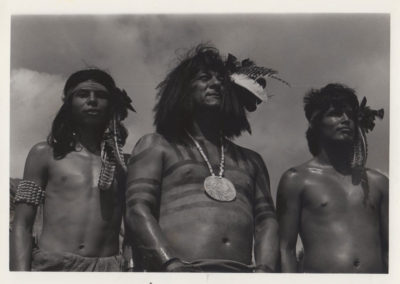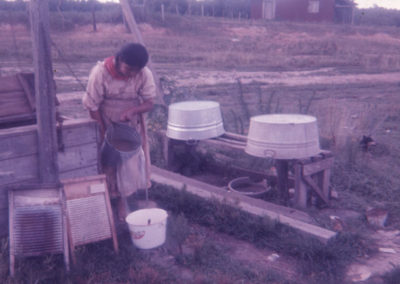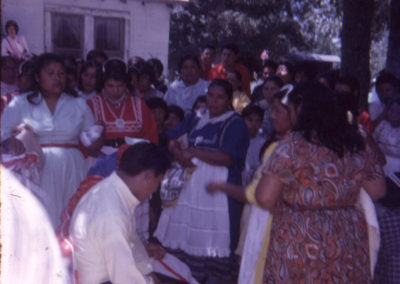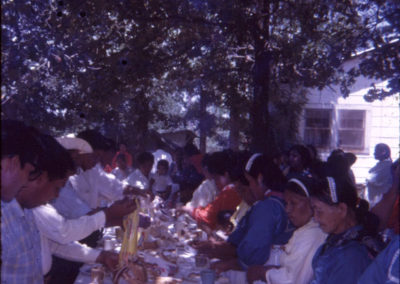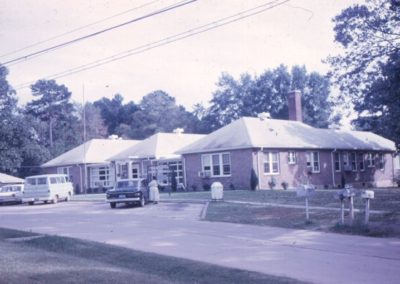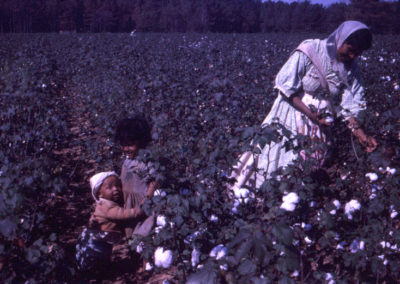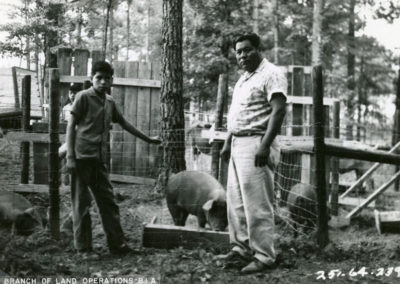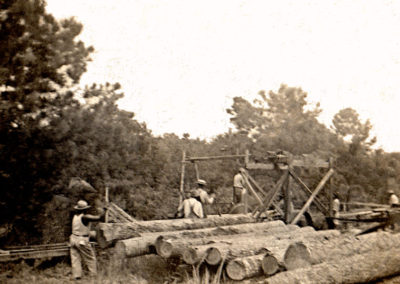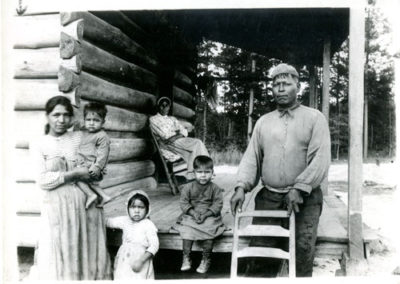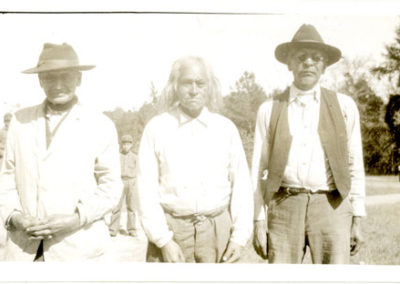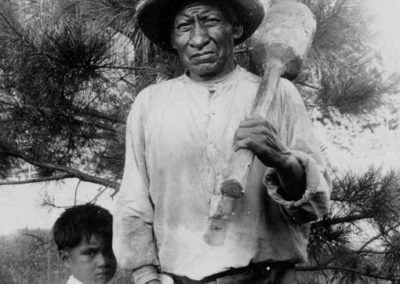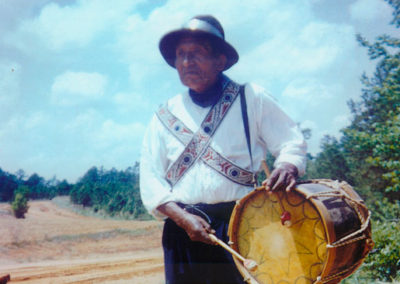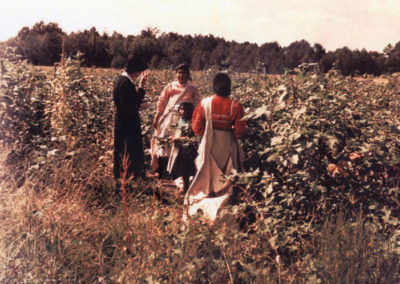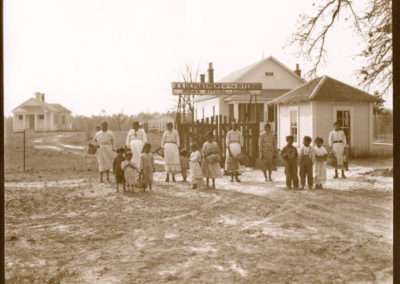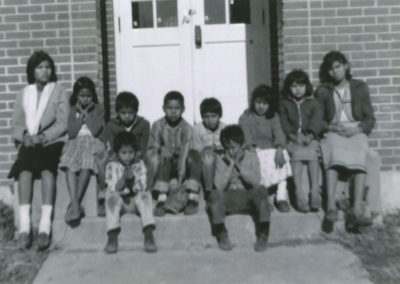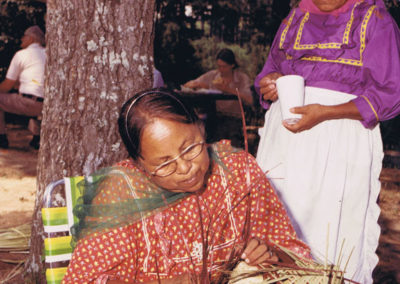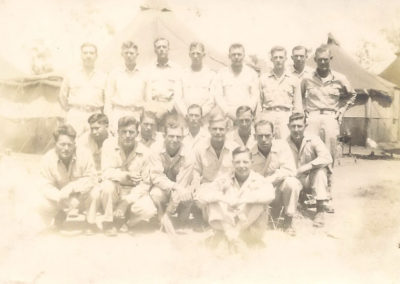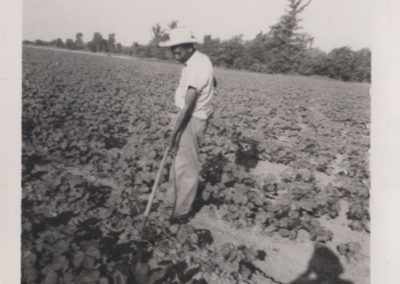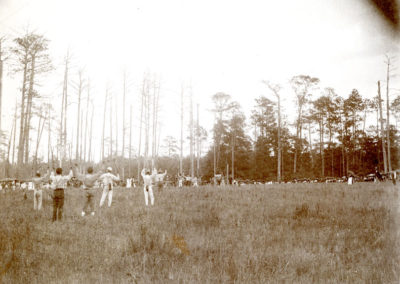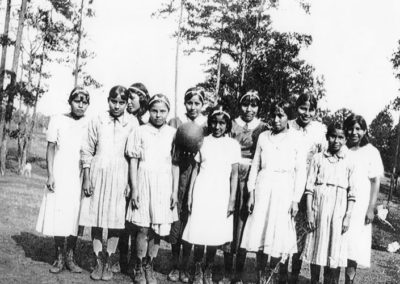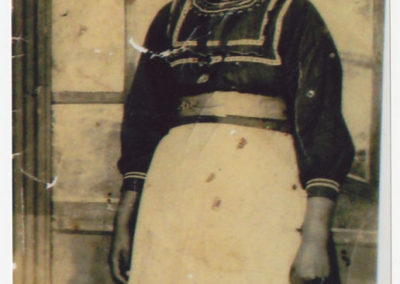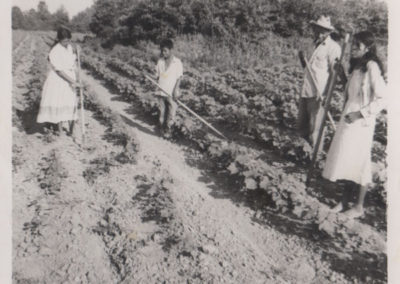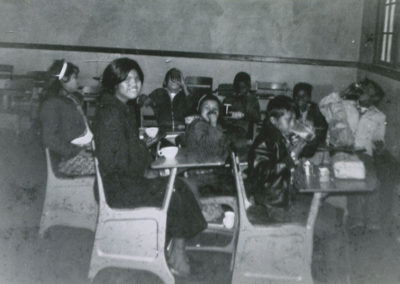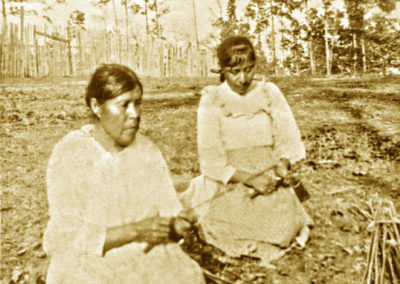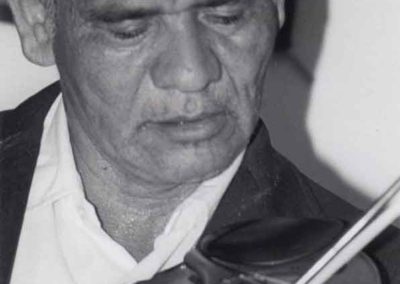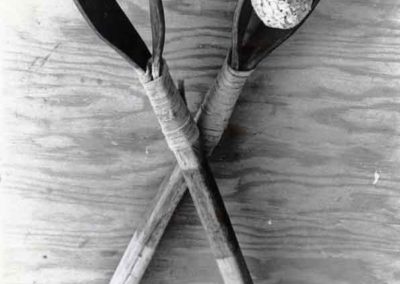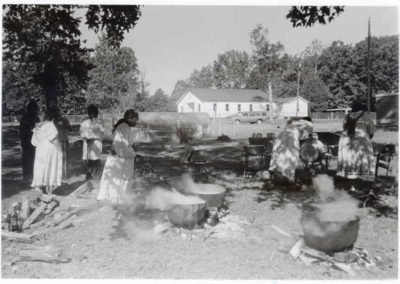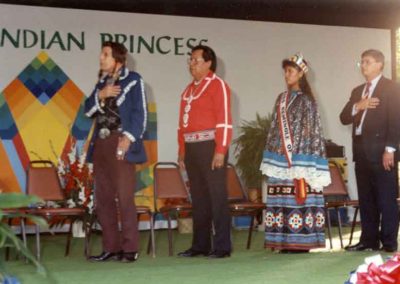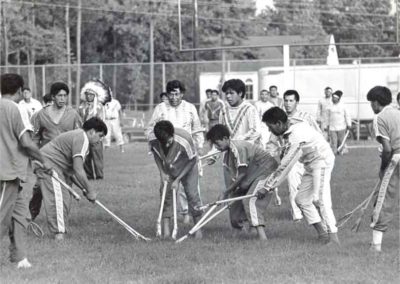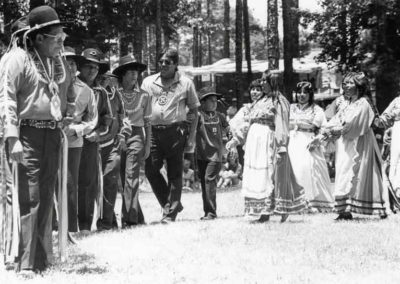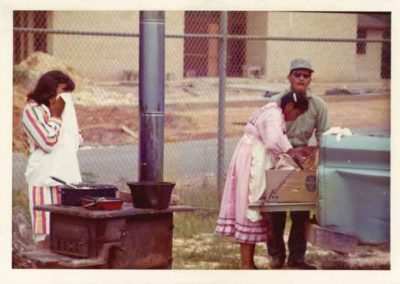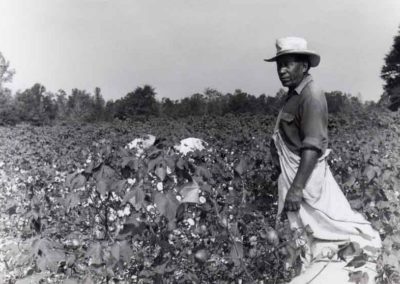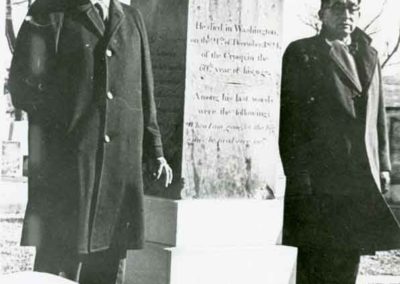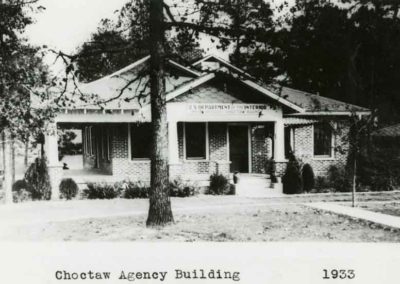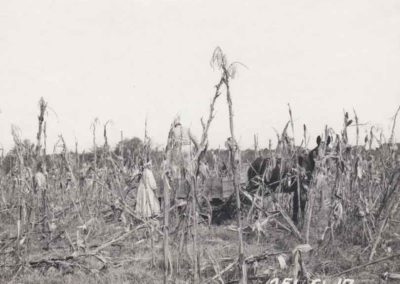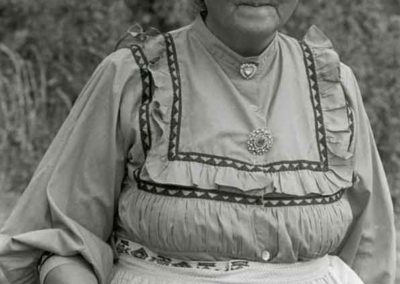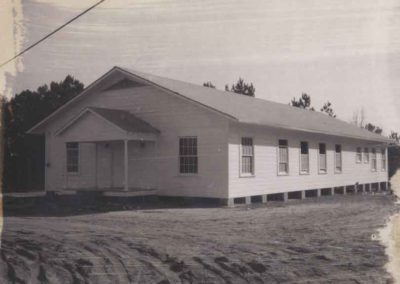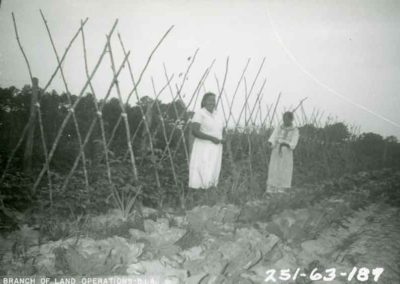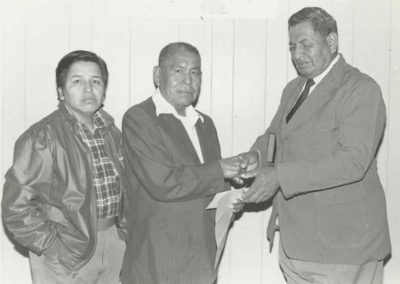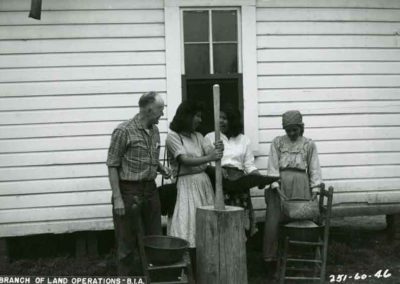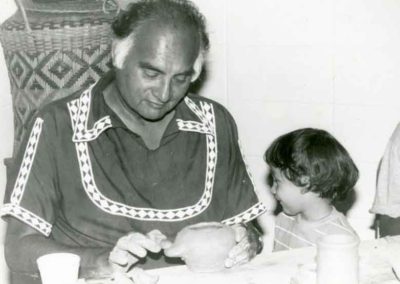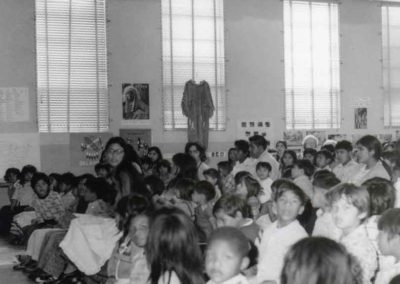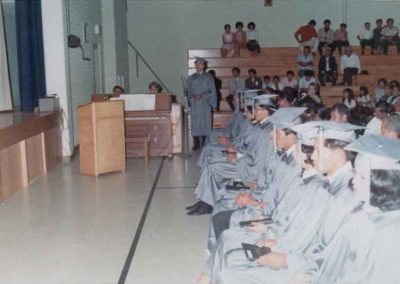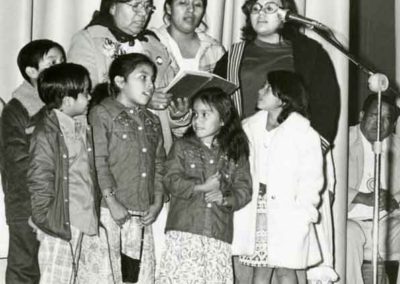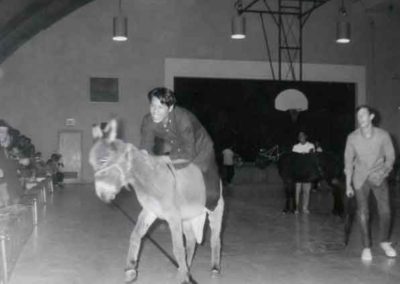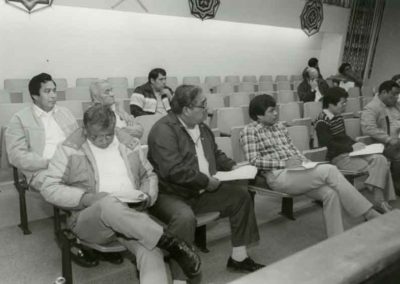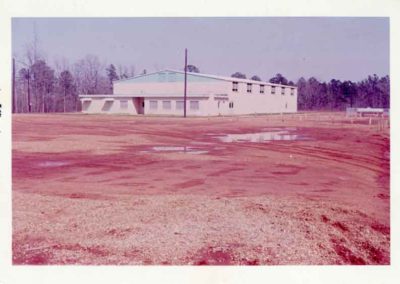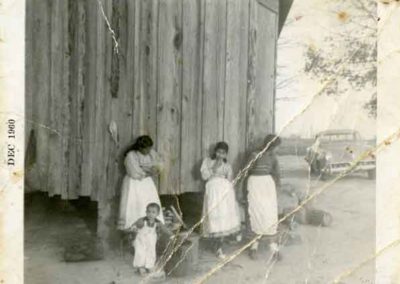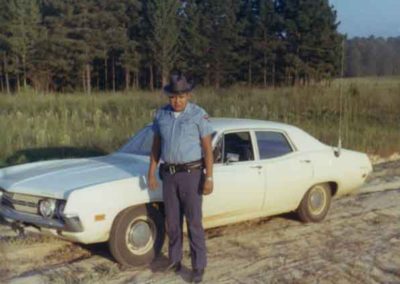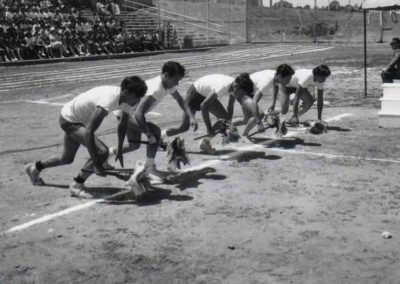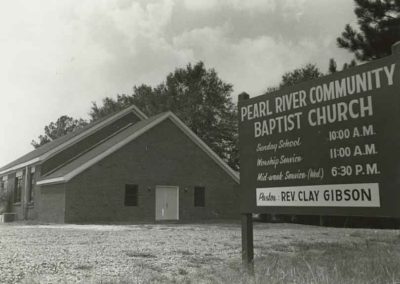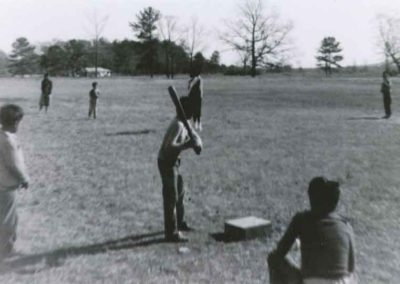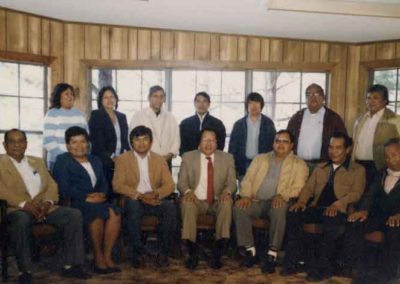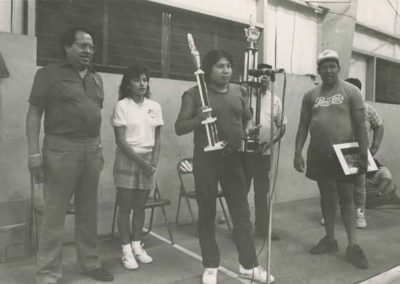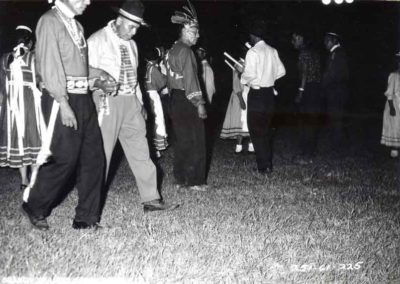Image Gallery
A collection of images that highlight Choctaw cultural categories such as foodways, clothing, work, music & dance, social life, religion and spirituality, historical events, tribal government and education.
Choctaw basket making process starts with gathering the cane. This photo shows basket maker, Eleanor Chickaway entering a cand stand to gather “Oski”(cane).
Choctaw Basket Artisan Eleanor Chickaway Entering a Cane Patch
It takes skill and knowledge to find and cut the right size cane. A large sharp knife is used to prep to the cane to carried out of the patch.
Eleanor Removes Excess Leaves
Further cutting is done to get the right length. The skillful basket maker knows exactly where to cut.
Cutting Down to The Right Size
After harvesting the swamp cane, basket makers begin a process of splitting, peeling, and dyeing the cane to prepare their material to make a Choctaw basket. In this photo, Norma Hall skillfully peel the cane into 4 pieces using an old technique.
Choctaw Basket Artisan Norma Hall Demonstrating an Old Technique
After many hours of peeling the cane, it is time to get ready for the dyeing process. The piles of cane strips will be grouped by colors. Norma is seen here tying up a bundle of cane to be dyed the color red.
Prepping Cane Strips for Dyeing
Here, Norma Hall dyes cane strips using modern-day techniques. Traditionally, cane strips would be dyed using natural material such as berries, flower roots, or bark to color the cane. Commercial dyes are used almost exclusively today because of their durability and the wide range of colors available.
Dyeing Cane Strips
After 30 minutes to an hour of boiling in red dye, this bundle of cane is pulled out reveling its beautiful color.
Bundle of Freshly Dyed Cane
Together the natural and color dyed cane are weaved to make an eye-catching diamond design for a basket.
Weaving Together the Natural and Color Dyed Cane
Taken during the 1960 Choctaw Indian Fair, this photo shows Donna Farmer (1959 -1960 Choctaw Indian Princess) crowning newly selected princess Earline Hickman (1960-1961 Choctaw Indian Princess.) Though the Choctaw Indian Fair began in 1949, the Princess Pageant wasn’t a part of the fair until 1955. Image used with permission from John Cumberland.
1960 – Choctaw Indian Fair Princess Earline Hickman
Bogue Chitto Social Dancers at the 1st Choctaw Indian Fair in 1949. Left to Right: Nancy Joe, Ellen Bell, Sally Henry, Annie Amos, Nanny Frazier, Mabel Jackson, Nellie Bell Willis, Cecilia Lewis Wesley, Hazel Frazier Willis, Levine Frazier, Cornelia Morris, ?, ?. Courtesy of Tribal Archives – Chahta Immi Cultural Center
1949 -1st Choctaw Indian Fair
4 Drummers circa 1960s: This postcard, from the late 1960s, was created for the promotion of the Choctaw Indian Fair. The photograph shows four drummers standing alongside each other, possibly during the drumming competition featured at the fair. Pictured left to right is Bob Henry, unknown, Isom Isom, and Bike Williamson. Feel free to contact us if you can identify the second drummer from the left. We would really appreciate it.
4 Drummers circa 1960s
1965 Choctaw Central High School: 1965 view of the Choctaw Central High School. Photo Courtesy of the Chahta Immi Cultural Center.
1965 Choctaw Central High School
Barney Wesley in the process of making a drum: Choctaw drum maker Barney Wesley is shaving down the outer area of the drum body. Circa 1980s. Photo Courtesy of the Chahta Immi Cultural Center.
Barney Wesley in the process of making a drum
Children Playing Stickball at the Fair ca. late 1960s – early 1970s: This is a photo of children playing stickball at the Choctaw Indian Fair. This photo was taken in either the Late 1960s or Early 1970s. Photo Courtesy of the Chahta Immi Cultural Center.
Children Playing Stickball at the Fair ca. late 1960s – early 1970s
Choctaw Wedding: Traditional Choctaw weddings were a simple ceremony involving family and friends. Often times, gifts in the form of ribbons were given to the couple and placed on top of the wife’s head. As the ribbons were placed on top of the wife’s head, her brothers and uncles would collect and hold the ribbons for the couple. Photo courtesy of
Choctaw Wedding
Close up photo of Barney Wesley making a drum: Barney Wesley uses his draw blade to shave and shape the outer area of the drum body. Circa 1980s. Photo Courtesy of the Chahta Immi Cultural Center.
Close up photo of Barney Wesley making a drum
LD John – Choctaw Pottery Maker: In this photo LD John is seen making Choctaw pottery. He first became interested in Choctaw pottery making in the 1940s. He and his cousin, Grady John, helped in revitalizing the traditional art form. Photo Courtesy of the Chahta Immi Cultural Center.
LD John – Choctaw Pottery Maker
Making a white oak basket: 1963 photo of a young girl making a white oak basket. Photo Courtesy of the Chahta Immi Cultural Center. According to information found on the photo (left to right) Maxine Stevens, Clyde Sockey, and Nephus Sockey taken on 6/18/1963.
Making a white oak basket for 1963 Choctaw Indian Fair 4-H exhibit
Segregated Seating: Choctaw women and children taking a rest at a bench designated for nonwhites and labeled as “COLORED.” Photo Courtesy of the Chahta Immi Cultural Center.
Segregated Seating
Timeout on the field: There is stoppage in play during the stickball game to allow players to drink water. The women in Choctaw dresses are providing the water to the teams. Photo Courtesy of the Chahta Immi Cultural Center.
Timeout on the field
BIA 251-63-356: The Choctaw drummer and young lad strike a pose, prior to a stickball game. Courtesy of Tribal Archives – Chahta Immi Cultural Center
The Choctaw drummer and young lad strike a pose, prior to a stickball game. Courtesy of Tribal Archives – Chahta Immi Cultural Center
BIA 251-63-262: This 1963 photo shows the resourcefulness of Choctaw people. They’re refurbishing lawn chairs with white oak strips. To the far right a man can be seen splitting white oak while the other two weave the white oak strips. Courtesy of Tribal Archives – Chahta Immi Cultural Center
This 1963 photo shows the resourcefulness of Choctaw people. They’re refurbishing lawn chairs with white oak strips. To the far right a man can be seen splitting white oak while the other two weave the white oak strips. Courtesy of Tribal Archives – Chahta Immi Cultural Center
Preparing rabbit stick for a hunt. Courtesy of Tribal Archives – Chahta Immi Cultural Center
Preparing rabbit stick for a hunt. Courtesy of Tribal Archives – Chahta Immi Cultural Center
David Weaver Collection: Two women at a well to draw water circa 1960s. Photo is from the David Weaver collection, courtesy of Tribal Archives – Chahta Immi Cultural Center
Two women at a well to draw water circa 1960s. Photo is from the David Weaver collection, courtesy of Tribal Archives – Chahta Immi Cultural Center
BIA 251-64-17: A Choctaw family picking cotton 1964. Courtesy of Tribal Archives – Chahta Immi Cultural Center
A Choctaw family picking cotton 1964. Courtesy of Tribal Archives – Chahta Immi Cultural Center
David Weaver Collection: Choctaw men preparing their plates for dinner. Photo was taken at a social gathering in the Mashulaville community circa 1970s. Photo is from the David Weaver collection, courtesy of Tribal Archives – Chahta Immi Cultural Center
Choctaw men preparing their plates for dinner. Photo was taken at a social gathering in the Mashulaville community circa 1970s. Photo is from the David Weaver collection, courtesy of Tribal Archives – Chahta Immi Cultural Center
BIA 251-64-18: 1964 photo of what looks to be a group of Choctaws on their way to eat lunch after attending a church service. Courtesy of Tribal Archives – Chahta Immi Cultural Center
1964 photo of what looks to be a group of Choctaws on their way to eat lunch after attending a church service. Courtesy of Tribal Archives – Chahta Immi Cultural Center
Dancing Rabbit Creek Treaty Marker. Courtesy of Billups-Garth Archives, Local History Department, Columbus-Lowndes Public Library (Columbus, MS)
Dancing Rabbit Creek Treaty Marker. Courtesy of Billups-Garth Archives, Local History Department, Columbus-Lowndes Public Library (Columbus, MS)
A crew of Choctaw men take time out from clearing tribal lands to pose for a photo. Courtesy of Tribal Archives – Chahta Immi Cultural Center
A crew of Choctaw men take time out from clearing tribal lands to pose for a photo. Courtesy of Tribal Archives – Chahta Immi Cultural Center
Crew member Darryl Revel applies face paint to Herman Willis during the filming of the docu-drama, First Frontier. The film, produced by the Media Production Group at Auburn University, tells the story of the Native people of the Southeast from the arrival of Hernando DeSoto through the Trail of Tears. Courtesy of Tribal Archives – Chahta Immi Cultural Center
Crew member Darryl Revel applies face paint to Herman Willis during the filming of the docu-drama, First Frontier. Courtesy of Tribal Archives – Chahta Immi Cultural Center
1984 photograph of Greg Shoemake, Darryl Tubby, and Norman Bell taking part in the docu-drama First Frontier. The film was produced by the Media Production Group at Auburn University. This scene is depicting the Choctaws first contact with Hernando Desoto during the Mobila Period. Courtesy of Tribal Archives – Chahta Immi Cultural Center
1984 photograph of Greg Shoemake, Darryl Tubby, and Norman Bell taking part in the docu-drama First Frontier. This scene is depicting the Choctaws first contact with Hernando Desoto during the Mobila Period. Courtesy of Tribal Archives – Chahta Immi Cultural Center
Annie Wallace drawing water from a well. Photo was taken in or near the Mashulaville area in the 1960’s. Image courtesy of Larry Miller.
Annie Wallace drawing water from a well. Photo was taken in or near the Mashulaville area in the 1960’s. Image courtesy of Larry Miller.
Traditional Choctaw wedding, groom’s family makes their way towards wedding site. 1960’s Mashulaville. Image courtesy of Larry Miller.
Traditional Choctaw wedding, groom’s family makes their way towards wedding site. 1960’s Mashulaville. Image courtesy of Larry Miller.
Traditional Choctaw wedding ceremony. 1960’s Mashulaville. Image courtesy of Larry Miller.
Traditional Choctaw wedding ceremony. 1960’s Mashulaville. Image courtesy of Larry Miller.
Traditional Choctaw wedding ceremony (2). 1960’s Mashulaville. Image courtesy of Larry Miller.
Traditional Choctaw wedding ceremony (2). 1960’s Mashulaville. Image courtesy of Larry Miller.
Wedding guests gather at the table after Choctaw wedding ceremony. 1960’s Mashulaville. Image courtesy of Larry Miller.
Wedding guests gather at the table after Choctaw wedding ceremony. 1960’s Mashulaville. Image courtesy of Larry Miller.
Choctaw Indian Hospital located in Philadelphia, Mississippi. Courtesy of Larry Miller.
Choctaw Indian Hospital located in Philadelphia, Mississippi. Courtesy of Larry Miller.
Lorene Wallace with two children in Mashulaville cotton field circa 1960 – 1970. Courtesy of Larry Miller.
Lorene Wallace with two children in Mashulaville cotton field circa 1960 – 1970. Courtesy of Larry Miller.
Choctaw women working on a quilt project together. 1960’s Mashulaville. Image courtesy of Larry Miller.
Choctaw women working on a quilt project together. 1960’s Mashulaville. Image courtesy of Larry Miller.
Photograph of BIA employee Tubby Thompson (right) taken in 1964. Courtesy of Tribal Archives – Chahta Immi Cultural Center
Photograph of BIA employee Tubby Thompson (right) taken in 1964. Courtesy of Tribal Archives – Chahta Immi Cultural Center
Choctaw men working at a sawmill operation in Newton County, MS. Circa 1950’s. Courtesy of Anita Johnson.
Choctaw men working at a sawmill operation in Newton County, MS. Circa 1950’s.
MUA_BCIMs09-1_26-07_05a
Choctaw family (Will Davis, wife, and children). Courtesy of Marquette University Archives, Bureau of Catholic Indian Missions Records, ID 09-1_26-07_05a
MUA_BCIMs09-1_26-07_06a
Photograph of George Polk, Sydney Wesley, and William Charley. Courtesy of Marquette University Archives, Bureau of Catholic Indian Missions Records, ID 09-1_26-07_06a
Festive gathering at Holy Rosary Indian Mission. Courtesy of Marquette University Archives, Bureau of Catholic Indian Missions Records, ID 09-1_26-07_51
Festive gathering at Holy Rosary Indian Mission. Courtesy of Marquette University Archives, Bureau of Catholic Indian Missions Records, ID 09-1_26-07_51
Culberson Davis and grandson, 1934. Courtesy of Marquette University Archives, Bureau of Catholic Indian Missions Records, ID 09-1 26-07
Culberson Davis and grandson, 1934. Courtesy of Marquette University Archives, Bureau of Catholic Indian Missions Records, ID 09-1 26-07
Photograph of Bike Williamson with his drum. This drum was passed down to Bike from his father, who used the drum during the Civil War. The drum was once displayed in the Archives and History Department at the state capitol in Jackson, MS. It is currently in the possession of the Williamson family and is still being used in special tribal events. Courtesy of Tribal Archives – Chahta Immi Cultural Center
Photograph of Bike Williamson with his drum. This drum was passed down to Bike from his father, who used the drum during the Civil War. Courtesy of Tribal Archives – Chahta Immi Cultural Center
Choctaw Women talking to Catholic Nun in a cotton field located in the Tucker community. Facing the photographer is Lillie Mae Billy and her daughter Sally Mae (Isaac) Steve: Courtesy of Holy Rosary Indian Mission located in Tucker, MS. Copy of this photo was donated by Dessie Billy Bownas
Choctaw Women talking to Catholic Nun in a cotton field located in the Tucker community. Facing the photographer is Lillie Mae Billy and her daughter Sally Mae (Isaac) Steve
Choctaw women and their children posing for a photo in front of the Indian Affairs School located in Bogue Homa, MS.: Collection of the Lauren Rogers Museum of Art, Laurel, Mississippi
Choctaw women and their children posing for a photo in front of the Indian Affairs School located in Bogue Homa, MS.
Choctaw children pose for a photo in front of the Choctaw Indian Mission School: The school was sponsored by the Mennonite churches within the Mashulaville community during the early 1960’s.
Choctaw children pose for a photo in front of the Choctaw Indian Mission School
1977 Choctaw Indian Fair photograph of Jeffie Solomon & Nancy Joe Frazier
1977 Choctaw Indian Fair photograph of Jeffie Solomon & Nancy Joe Frazier
Choctaw Drummer, 1900? – 1915?: Courtesy of Marquette University Archives, Bureau of Catholic Indian Missions Records, ID 09-1 OS-01-08
Choctaw Drummer, 1900? – 1915? Courtesy of Marquette University Archives, Bureau of Catholic Indian Missions Records, ID 09-1 OS-01-08
Group photo of G Company, 35th Regiment, 25th Infantry Division. Medic Pfc. Gipson T. McMillan (of the Tucker community) is seated on the bottom left of the photo: Courtesy of Sgt. Thomas A. “Andy” Roach. McMillan served during World War II from 1943-1945. McMillan was killed in action in Germany, February 7, 1945 and awarded the Purple Heart. He is buried in the Holy Rosary Church Cemetery in Neshoba County, Mississippi.
Group photo of G Company, 35th Regiment, 25th Infantry Division. Medic Pfc. Gipson T. McMillan (of the Tucker community) is seated on the bottom left of the photo.
Choctaw cotton farmer, 1934: Courtesy of Marquette University Archives, Bureau of Catholic Indian Missions Records, ID 09-1 26-07
Choctaw cotton farmer, 1934 Courtesy of Marquette University Archives, Bureau of Catholic Indian Missions Records, ID 09-1 26-07
July 4, 1896 Stickball Game in Laurel, MS: Collection of the Lauren Rogers Museum of Art, Laurel, Mississippi
July 4, 1896 Stickball Game in Laurel, MS
Girls Basketball Team: (Left to Right) Front Row- Catherine Isaac, Effie Isaac Tubby, Ivenia Lewis Bell, Lillie Isaac Billy, Ina Tubby Wade, Effie Bell Tubby, Sally Willis John. Back Row- Celia Davis Simpson, Bernice Lewis Henry, Annie Isaac York, Bernice Isaac.
Girls Basketball Team
Choctaw man in traditional dress wearing German silver crown, 1900? – 1915?: Courtesy of Marquette University Archives, Bureau of Catholic Indian Missions Records, ID 09-1 OS-01-08
Choctaw man in traditional dress wearing German silver crown, 1900? – 1915? Courtesy of Marquette University Archives, Bureau of Catholic Indian Missions Records, ID 09-1 OS-01-08
Photo of Choctaw Indian Mission School students on lunch break: Mashulaville, MS early 1960’s. Courtesy of Tracie Gibson
Photo of Choctaw Indian Mission School students on lunch break
Allie Chitto Comby (left) and other unknown tribal member stripping cane in the Standing Pine community
Allie Chitto Comby (left) and other unknown tribal member stripping cane in the Standing Pine community
John Amos – Choctaw Fiddle Player. Courtesy of Tribal Archives – Chahta Immi Cultural Center
John Amos – Choctaw Fiddle Player
Stickball Sticks and Ball. Courtesy of Tribal Archives – Chahta Immi Cultural Center
Stickball Sticks and Ball
Traditional Choctaw Cooking.Courtesy of Tribal Archives – Chahta Immi Cultural Center
Traditional Choctaw Cooking
Stickball Team on their way to play – Choctaw Indian Fair ca. 1962. Courtesy of Tribal Archives – Chahta Immi Cultural Center
Stickball Team on their way to play – Choctaw Indian Fair ca. 1962
Chief Phillip Martin with Iron Eyes Cody at the Choctaw Indian Fair. Courtesy of Tribal Archives – Chahta Immi Cultural Center
Chief Phillip Martin with Iron Eyes Cody at the Choctaw Indian Fair
Stickball Game in action. Courtesy of Tribal Archives – Chahta Immi Cultural Center
Stickball Game in action
Social Dancers at the Choctaw Indian Fair ca. 1980. Courtesy of Tribal Archives – Chahta Immi Cultural Center
Social Dancers at the Choctaw Indian Fair ca. 1980
Choctaw man and women cooking. Courtesy of Tribal Archives – Chahta Immi Cultural Center
Choctaw man and women cooking. Courtesy of Tribal Archives – Chahta Immi Cultural Center
Phillip Martin and Emmett York: at the Congressional Cemetery visiting the gravesite of Chief Pushmataha. Courtesy of Tribal Archives – Chahta Immi Cultural Center
Phillip Martin and Emmett York
Choctaw Agency Building in 1933. Courtesy of Tribal Archives – Chahta Immi Cultural Center
Choctaw Agency Building in 1933
Choctaw Man and Woman Harvesting Dired Corn, 1961. Courtesy of Tribal Archives – Chahta Immi Cultural Center
Choctaw Man and Woman Harvesting Dired Corn, 1961
Choctaw Men Playing Baseball. Courtesy of Tribal Archives – Chahta Immi Cultural Center
Choctaw Men Playing Baseball. Courtesy of Tribal Archives – Chahta Immi Cultural Center
Newly Built Corinth Baptist Indian Church – Tucker community 1972. Courtesy of Tribal Archives – Chahta Immi Cultural Center
Newly Built Corinth Baptist Indian Church – Tucker community 1972
Ida Mae Frazier and Lillie Tubby working in the garden. Courtesy of Tribal Archives – Chahta Immi Cultural Center
Ida Mae Frazier and Lillie Tubby working in the garden. Courtesy of Tribal Archives – Chahta Immi Cultural Center
Hopewell Baptist Church (Emerson Isaac, Charlie Denson, Carter Williams). Courtesy of Tribal Archives – Chahta Immi Cultural Center
Hopewell Baptist Church (Emerson Isaac, Charlie Denson, Carter Williams). Courtesy of Tribal Archives – Chahta Immi Cultural Center
Preparing Hominy Corn. Courtesy of Tribal Archives – Chahta Immi Cultural Center
Preparing Hominy Corn
Grady John – Choctaw Potter. Courtesy of Tribal Archives – Chahta Immi Cultural Center
Grady John – Choctaw Potter
First Graduating Class of Choctaw Central High School. Courtesy of Tribal Archives – Chahta Immi Cultural Center
First Graduating Class of Choctaw Central High School
Farming with a Horse Plow. Courtesy of Tribal Archives – Chahta Immi Cultural Center
Farming with a Horse Plow. Courtesy of Tribal Archives – Chahta Immi Cultural Center
Hope Indian Baptist Church members singing. Courtesy of Tribal Archives – Chahta Immi Cultural Center
Hope Indian Baptist Church members singing. Courtesy of Tribal Archives – Chahta Immi Cultural Center
Donkey Basketball School Event at Choctaw Central High School. Courtesy of Tribal Archives – Chahta Immi Cultural Center
Donkey Basketball School Event at Choctaw Central High School. Courtesy of Tribal Archives – Chahta Immi Cultural Center
Councilman (at council hall). Courtesy of Tribal Archives – Chahta Immi Cultural Center
Councilman (at council hall). Courtesy of Tribal Archives – Chahta Immi Cultural Center
People Farming with Horse Plow. Courtesy of Tribal Archives – Chahta Immi Cultural Center
People Farming with Horse Plow
Committee System building – Pearl River Community. Courtesy of Tribal Archives – Chahta Immi Cultural Center
Committee System building – Pearl River Community
Colleen Frazier, Joann Frazier, Bobby Jean Frazier and Donald Frazier. Courtesy of Tribal Archives – Chahta Immi Cultural Center
Colleen Frazier, Joann Frazier, Bobby Jean Frazier and Donald Frazier. Courtesy of Tribal Archives – Chahta Immi Cultural Center
Choctaw PolicemanCourtesy of Tribal Archives – Chahta Immi Cultural Center
Choctaw Policeman. Courtesy of Tribal Archives – Chahta Immi Cultural Center
Choctaw Central High School field day event. Courtesy of Tribal Archives – Chahta Immi Cultural Center
Choctaw Central High School field day event
Pearl River Community Baptist Church. Courtesy of Tribal Archives – Chahta Immi Cultural Center
Pearl River Community Baptist Church
Choctaw Boy and Girl Dancing. Courtesy of Tribal Archives – Chahta Immi Cultural Center
Choctaw Boy and Girl Dancing
Chief Phillip Martin and Councilmen ca. 1980. Courtesy of Tribal Archives – Chahta Immi Cultural Center
Chief Phillip Martin and Councilmen ca. 1980
1988 Tucker Stickball Champions. Courtesy of Tribal Archives – Chahta Immi Cultural Center
1988 Tucker Stickball Champions
